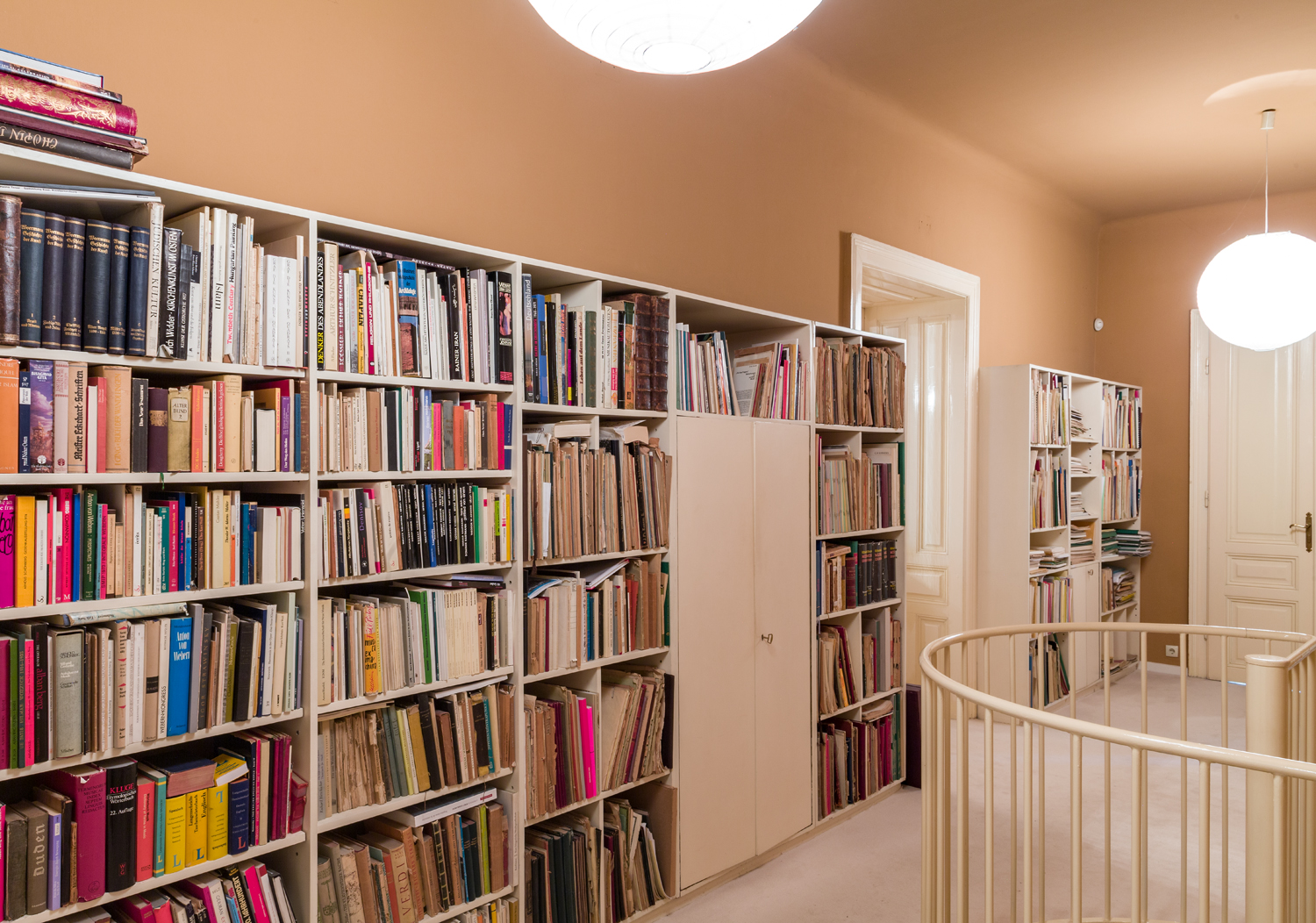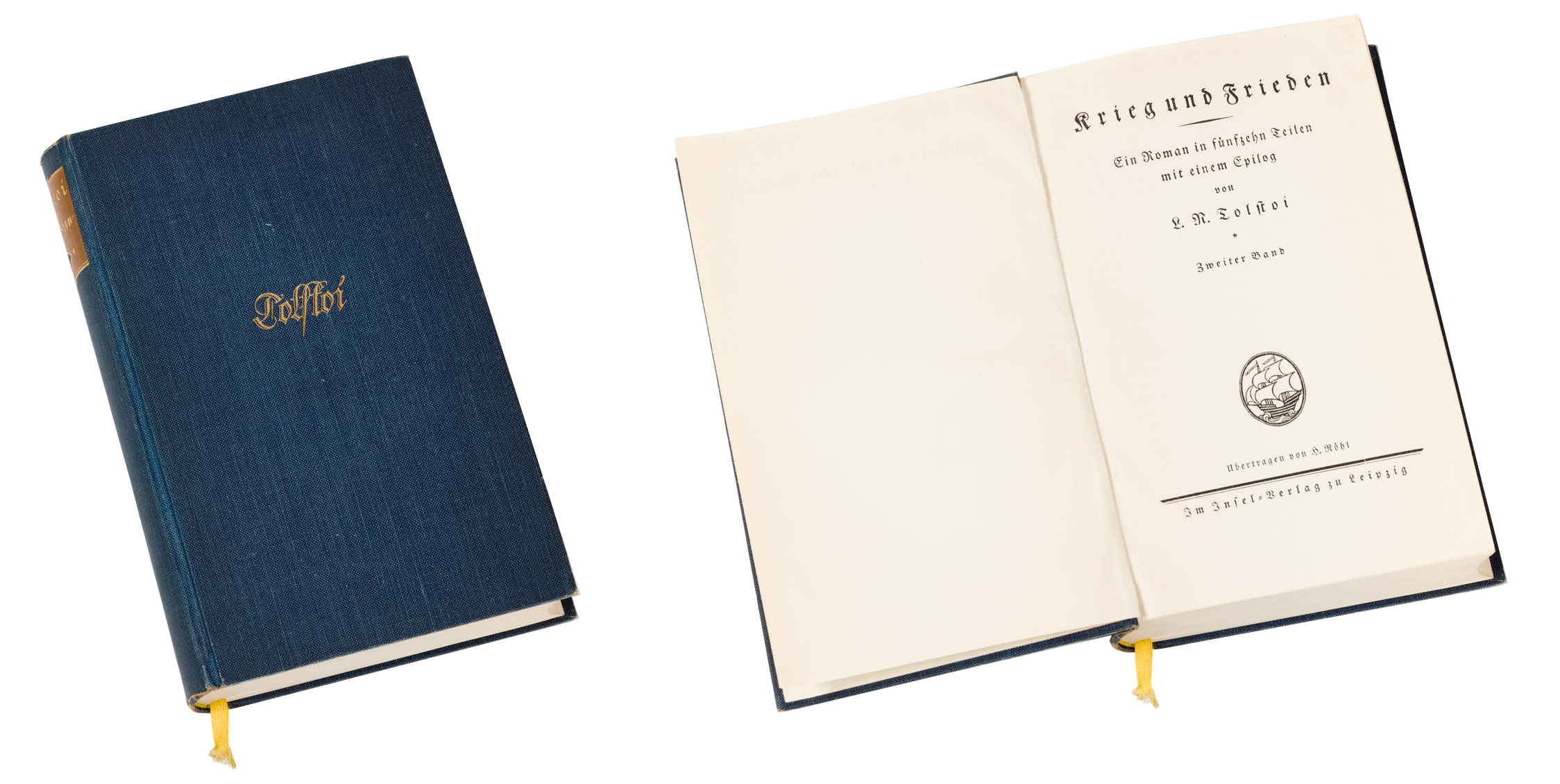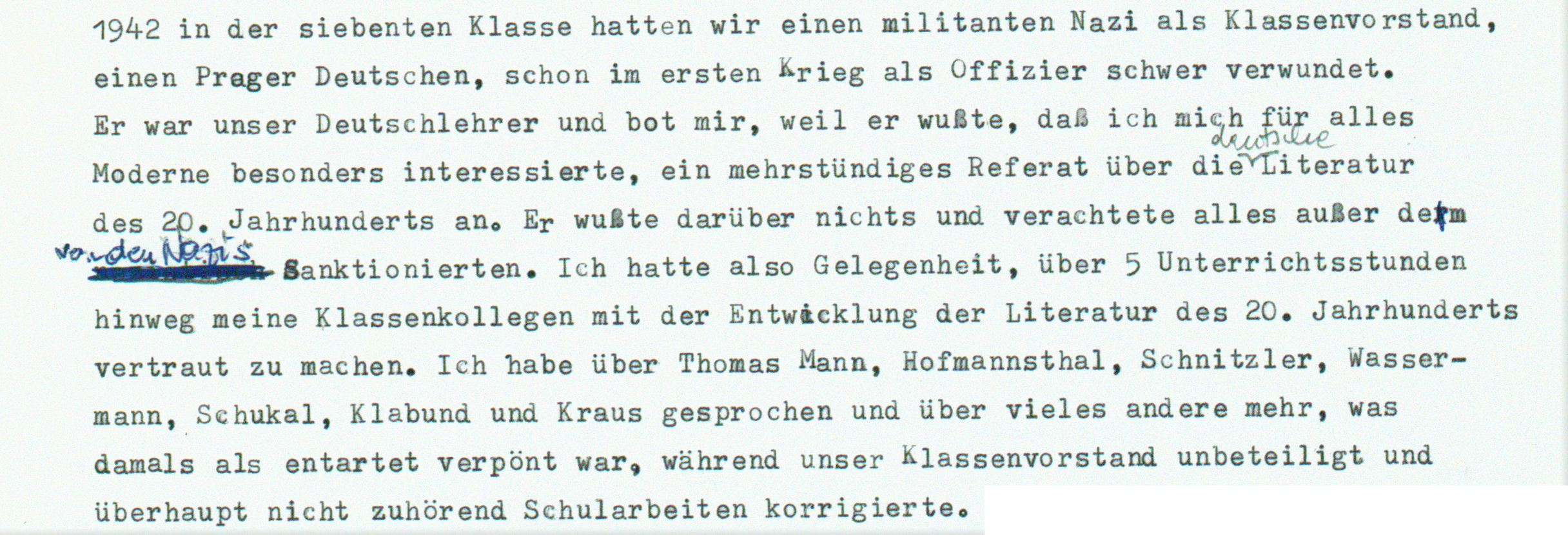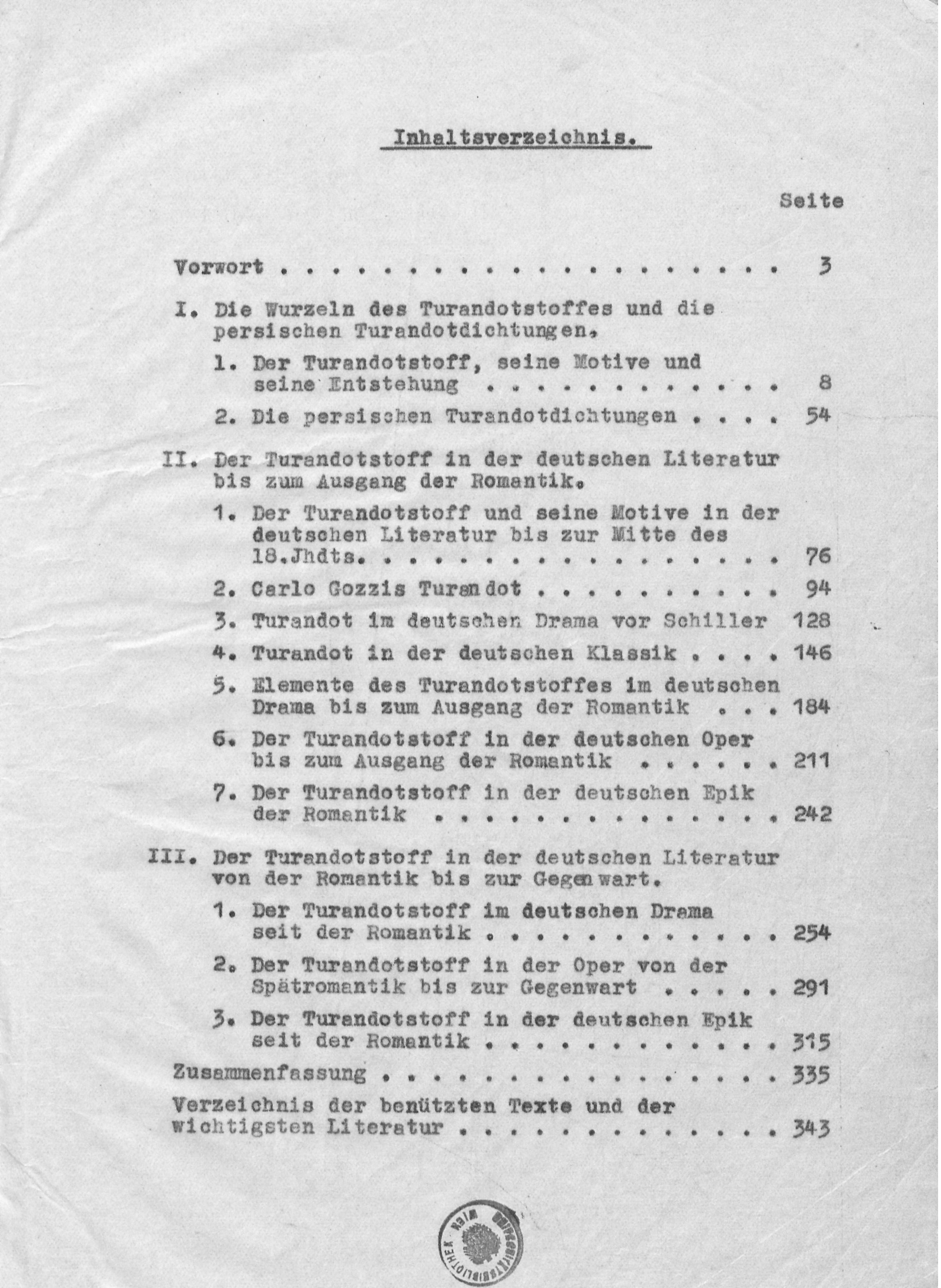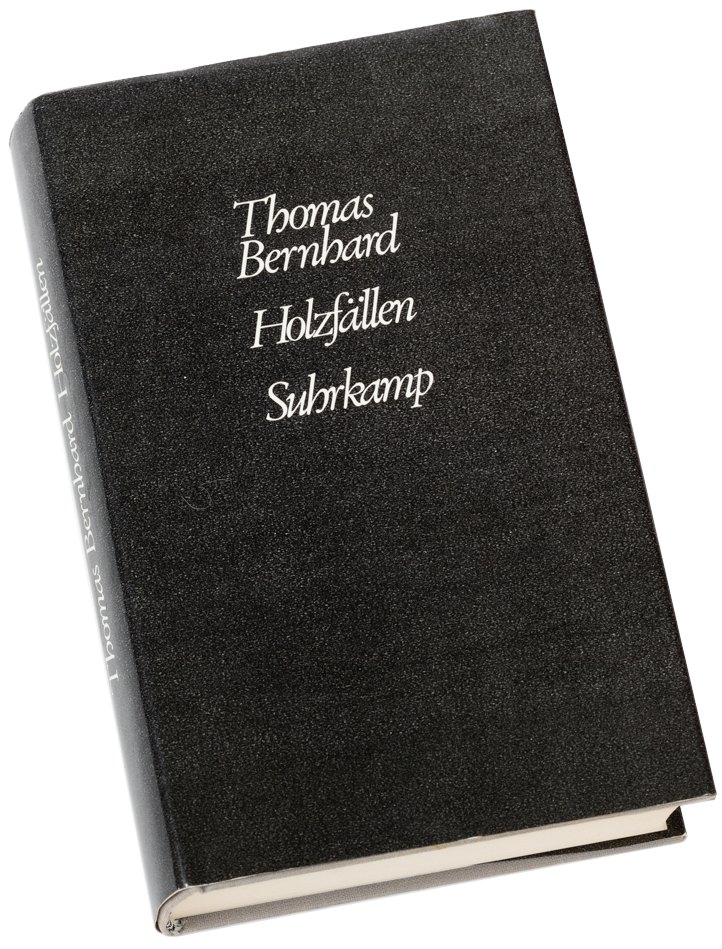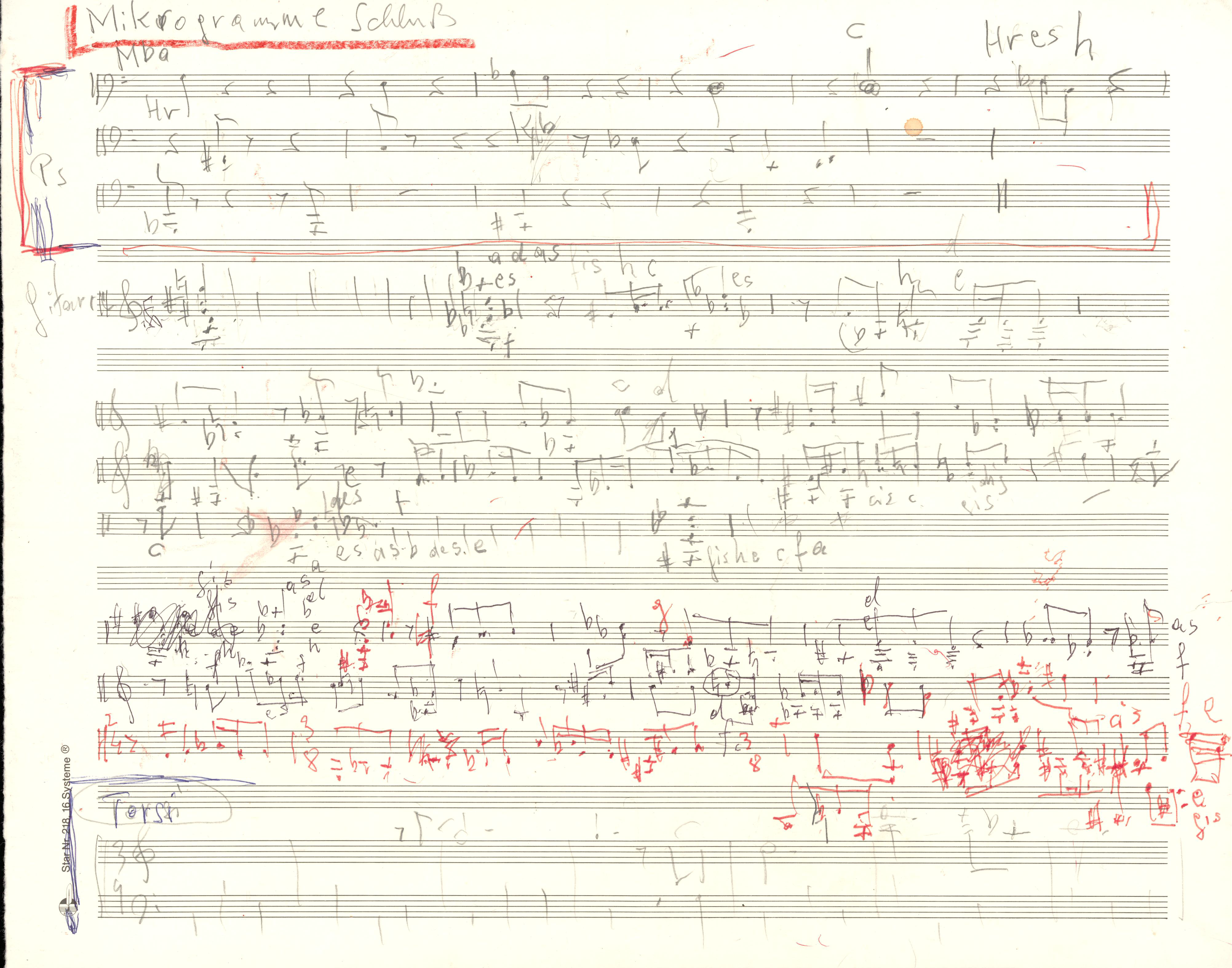The Reader
Cerha at his desk.
Cerha’s glasses are one of the most important tools in his day-to-work work. They are an indispensable companion, especially at his desk, as he composes, for example. Hertha Hurnaus photographed Cerha reading at his residence in Maria Langegg.
Photo: Hertha Hurnaus.
A peek into Cerha’s private library at his apartment in Vienna Hietzing.
Photo: Christoph Fuchs
Friedrich Cerha is also a very well-read individual—books are, for him, far more than a mere vessel for enjoyment. His immense interest in the history of literature was intense from a very early age. For a long time it even seemed as if the art of language was equally important to him as music, if one considers the effort with which he devoted himself to the two areas. His reading has always ranged from the classics of global literature to contemporary authors, some of whom he even met personally. But there are also countless specialised books to be found in his private library in Vienna. The spectrum of topics is by no means limited to the field of music, but includes philosophy, psychology, fine arts, natural sciences, religion, history, anthropology, and more. Music journalist Bálint András Varga aptly described Cerha as a “Poeta doctus”, an “artist with tremendous knowledge.”Sabine Töfferl, Friedrich Cerha. Doyen der österreichischen Musik der Gegenwart, Eine Biografie, Vienna 2017, p. 236
Literature from the Perspective of Cerha as a Youth
He was the son of a clothing mender and when one entered his apartment, one first came into a windowless kitchen with a huge brick stove, then into a dark room where his parents and their helpers were mending and sewing. A whole new world opened up in the next room: It was a large and bright room, furnished in the modern style of the late 1930s, with a Bösendorfer grand and a huge library. Pejhovsky was a Pan-Slavist. Not only do I owe my thorough violin training to him, he also gave me Tolstoy, Dostoyevsky, Chekhov, Hašek, Gorki, and others to read when I was eleven.
Friedrich Cerha
Schriften: ein Netzwerk, Vienna 2001, p. 20
Cerha, excerpt from the manuscript “The Jews, Czechs, Slovaks, Mahder, Gypsies, the Nazis, and Again the Jews”, (early version), undated.
In the turmoil of World War II, the role played by literature in the young man’s life changed. Called in for military service, twice deserting and wandering the country, Cerha always carried a single book with him. It was Kant’s last work, published in 1798, Anthropology from a Pragmatic Point of View. The book helped its reader to reflect upon the basic characteristics of human beings as “animal rationabile” while experiencing the irrational events of the times. In the second part of the book, Kant questions the “anthropological characteristics” in ascending order from groups of individuals (gender, nation, race) to humanity as a whole—providing a basis for Cerha to understand the very essence of human nature. Questions such as these stayed with him for decades, influencing not least his stage works. After 1945, Cerha was able to overcome his war-fuelled distrust of civilised humanity only with great effort. A staunch humanist, he did ultimately come to view society with a fresh outlook.
Cerha, the Germanist
The end of the war and the start of Cerha’s academic career coincide almost exactly. He was already enrolled at the University of Vienna in the summer semester of 1944. However, he soon had to interrupt his studies when he was drafted into the army. In 1945, he picked up where he had left off—with the subjects of German, Philosophy, and Musicology. A year later he was accepted into the Vienna Music Academy to study Violin, Composition, and Music Education. This dual track—on the one hand studying science, and on the other hand art—reflects the broad interests of the young man only recently returned from war.
For Cerha, an avid reader, studying German opened up new horizons. From semester to semester, he was able to deepen his already impressive education, especially with regards to the history of German and Austrian literature. His textbooks reveal the primary focal points. Most of the lectures he attended were devoted to medieval studies, for example “German Prose and Poetry from the Eighth to the Tenth Centuries” or “Austrian Literature of the Middle Ages”. Cerha wrote the first pieces of his song cycle Ein Buch von der Minne in the first year after the war, testament to the synergies arising from his studies. Cerha himself translated into High German the texts on which the songs are based (written by Walther von der Vogelweide, Mechthild von Magdeburg, and Heinrich von Morungen, among others).
In addition to Middle High German poetry, more recent literature was also among his areas of great interest; he attended, for example, lectures on “Spoken German Poetry”, Gerhart Hauptmann’s dramas, Sturm und Drang and the “young Goethe”, “Literature of Humanism and the Renaissance”, the history of the novel and novella, and the dramas of the classical period. It is remarkable that no contemporary literature courses are found among his textbooks, which Cerha always had a strong affinity for. On this point, the classically oriented courses offered by the University of Vienna coincided with the conservative education of the music academy, where Cerha also missed having a view of the contemporary. Similar to the way he had once proceeded autodidactically in the field of music, studying modern scores on his own, Cerha shifted his examination of contemporary literature into his private life.
Just as his interest in medieval literature left traces in Cerha’s work, so did Persian poetry—for the first time in Zehn Rubaijat des Omar Chajjam, choral pieces based on the writings of Persian polymath Omar Khayyam. The first of these pieces were written in 1949, at the same time that Cerha was still working away at his doctoral thesis. His fascination with Middle Eastern texts with philosophical undertones (which, by the way, were also from the Middle Ages) proved to be durable: Cerha wrote another Rubaijat cycle in 1988.
Cerha, Der Turandotstoff in der deutschen Literatur, table of contents, 1950.
Literature Becomes Music: The Reading Composer
The connection between literature and music runs through Cerha’s entire oeuvre. He began setting poems to music in 1940 to 1942, around 40 in all. In the 1960s, he destroyed these manuscripts, keeping only two pieces, one by Eduard Mörike and the other by Theodor Storm. In the mid-1940s, another name came to the fore: Hildegard Haustein, a poet largely unknown today. Cerha used her lyrics several times: for the lullaby Schlaf ein, in several songs of Sechs Lieder für Singstimme und Klavier (along with poems by Li Tai Pe, Joseph v. Eichendorff, and Erika Mitterer), and the lost piano cycle titled Märchenland.
After these early songs, Buch von der Minne and Zehn Rubaijat des Omar Chajjam are the next striking examples of Cerha’s way of working with poetry. His stage pieces stand in contrast to the cyclically integrated, miniature works of poetry: This is true above all of the literary opera Baal, based on the five versions of the eponymous drama by Bertolt Brecht, which Cerha blended with virtuosity into a condensed version. He had already devoted himself to the poet as a student:
In around 1948 I started reading all of Brecht’s plays. I devoured them, the early pieces first. The poems came later. I encountered the Berlin Ensemble much later, in 1958, and was more interested in the technical aspects of its theatre. I was with Ernst Krenek at the time, […] in Berlin, and saw Galilei in 1960/61, along with many other pieces. But my adoration of the early pieces never stopped. With all due respect to the later pieces, my love remains even to this day with the earlier works. I think I already saw musical drama in Baal the very first time I read it, but at the time had no way of approaching such a task.
Friedrich Cerha
[Albrecht Dümling]: “Brechts Sprachrhythmik beeinflußt musikalische Vorstellungen”, a conversation with Friedrich Cerha, in: Albrecht Dümling: Laßt euch nicht verführen. Brecht und die Musik, Munich 1985, pp. 648–658, here p. 649
While Baal and Der Rattenfänger are sui generis in the literary cosmos of what Cerha set to music, he was also strongly influenced by other authors, above all by Friedrich Hölderlin, Günther Anders, and Thomas Bernhard, whose words the composer featured in more than one opus. Cerha also met the latter two personally—Günther Anders (*1902), a generation older, first. The philosopher and writer had a remarkable feeling for music, was interested in questions of aesthetics, and wrote articles for music magazines Anbruch and Musikwelt in which he pondered contemporary musicians such as Claude Debussy, Ferruccio Busoni, and Arnold Schönberg. “I learned how to write,” said Anders, “from the great composers.”Günther Anders, Ketzereien, Munich 1982, p. 202 He also left behind a number of writings on the philosophy of music, and it is thus quite logical that he sought contact with the composers of the time throughout his life. They met in the 1950s, and Cerha became one of the composers with the closest contact with him. Their first joint project, Und Du…, a political radio piece of tremendous scope, also proved to be a literary collaboration: Cerha wrote part of the libretto and prepared a text by Anders to be recited at the end of the piece. The philosopher performed this spoken section himself. Two shorter pieces by Anders later found their way into Cerha’s music. His Drei bedenklichen Geschichten, performed by the chamber choir and string quartet, reach back to the Ketzereien, a cryptic notebook by the philosopher.
“Long discussions and conversations [that] went on into the dead of night” were characteristic of the ambience in Maria Saal.Cerha in: Sepp Dreissinger (ed.): Was reden die Leute. 58 Begegnungen mit Thomas Bernhard, Salzburg 2011, p. 53 “There was a characteristic, slightly cheeky conversational style that prevailed,” says Cerha, “[…] which later found its way into Bernhard’s novels—stylistically elevated with excellence to another level.” Cerha devoted himself to Bernhard’s work not only as a reader, but also as a composer. He took, for example, passages from Bernhard’s experimental novella Walking and integrated them theatrically in his Requiem für Hollensteiner. A few years later, Cerha read Bernhard’s new novel The Woodcutters. On a somewhat spicy note, Bernhard only slightly masked accounts of Gerhard and Maja Lampersberg, his former patrons, taking task as well with other figures from the Tonhof scene. This was the start of a rousing literary scandal, which was of little interest to Cerha. He was, however, fascinated by the last pages of the novel, in which the narrator is internally and externally running to escape. “When reading and rereading these pages, they became music to me,” comments Cerha, “a nervous, hasty, restless tune—a music of senseless rushing forward, of being driven, of being hunted.”Schriften: ein Netzwerk, Vienna 2001, p. 277 The final words of the novel become the title for Cerha’s grand orchestral song: bevor es zu spät ist (before it is too late).
Some later works also show a tendency to conceal their literary inspiration, although Cerha continues to set verses to music in the more traditional sense (for example, Austrian poet Emil Breisach’s work in the cycles Aderngeflecht and Auf der Suche nach meinem Gesicht). Their titles are often allusions to literature, sometimes even hinting at synesthetic perceptions, for example in the 2013 piece for orchestra Eine blassblaue Vision (die sich in der Morgendämmerung langsam auflöst, Knabenmorgenblütentraum)—also the longest title in Cerha’s oeuvre. It refers on the one hand to Franz Werfel’s story Eine blassblaue Frauenhandschrift, which the composer had reread a few weeks before the initial experience (a kind of dream) for his orchestral work. On the other hand, the lyrics of young Goethe can also be identified. See Cerha, 1946 student handbook, The Archives of Contemporary Arts, pp. 9 and 11 “Knabenmorgenblütentraum” (a young boy’s morning dream of blossoms), a word from his poem “Prometheus”, did not find its way into the title until later, when Cerha stumbled over it in an old edition: “The very scent of this word creation, the atmosphere it exuded, corresponded exactly to that of my dream and—I hope—to that of my music.”Joachim Diederichs: Friedrich Cerha. Werkeinführungen, Quellen, Dokumente, Vienna 2018, p. 129
The Sturm und Drang phase, which is expressed to perfection in Goethe’s poem and which occupied Cerha extensively during his studies, reappears musically in the ensemble piece Kurzzeit (2016/17). These experimentations result in a kaleidoscope of rhythmically superimposed pulsations—like the “knocking signal of a lonely prisoner”,Walter Weidringer, “Wien Modern: Kerkerklänge und Kleopatras Lied”, Die Presse, 22 November 2018, https://www.diepresse.com/5534661/wien-modern-kerkerklange-und-kleopatras-lied as one reviewer of the premiere described it. Shortly before composing the piece, Cerha had read the 1768 drama Ugolino by Heinrich Wilhelm von Gerstenberg, about a father and his three sons who are imprisoned and face the end of their days. “It is possible that my reading influenced the creation of my piece”, notes the composer cautiously.
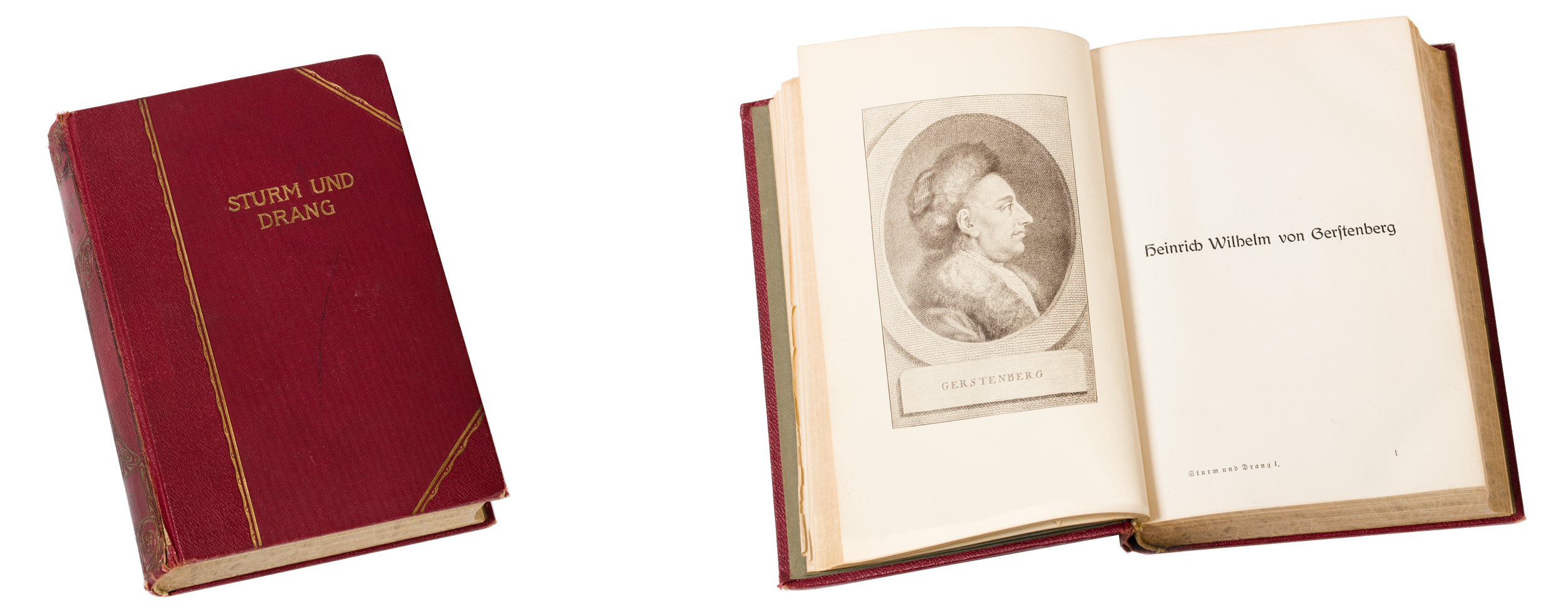
Karl Freye (ed.), Sturm und Drang. Dichtungen aus der Geniezeit, Berlin, et al., 1911. Cerha’s private copy.
Foto: Christoph Fuchs
Just how difficult it became for Cerha to read and write in his old age is illustrated by his most recent piece with a literary reference. The title, Mikrogramme, alludes to Robert Walser, whose work (letters, novels, and poems) can be found in Cerha’s library. Walser wrote his “micrograms” in miniscule letters on over 500 sheets of paper while in a mental hospital. It took scholars years of hard work to decipher them. The writer spent years perfecting his cryptic writing technique, condensing it with his pencil as a reliable tool. In the 1990s, Cerha likewise switched from ink to pencil to make his work easier. His manuscripts for Mikrogramme are nevertheless testimony to how increasingly difficult the task of writing became with age: Notes, characters, and letters appear to have been laboriously wrested from his hand.
Cerha, Mikrogramme, sketches at the end of the piece, 2018.

